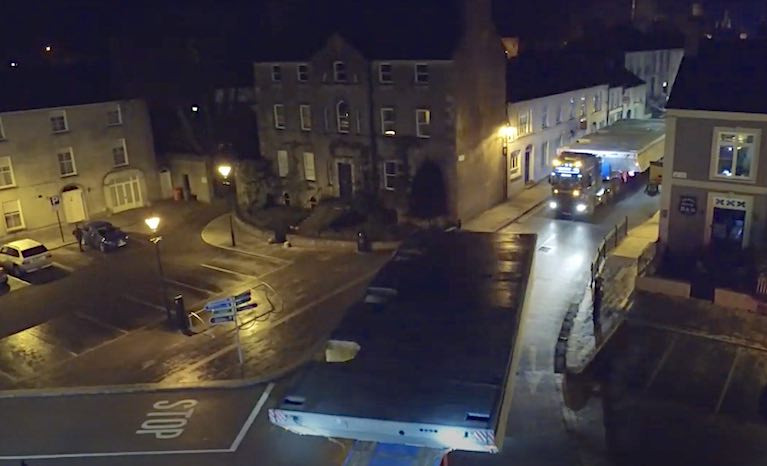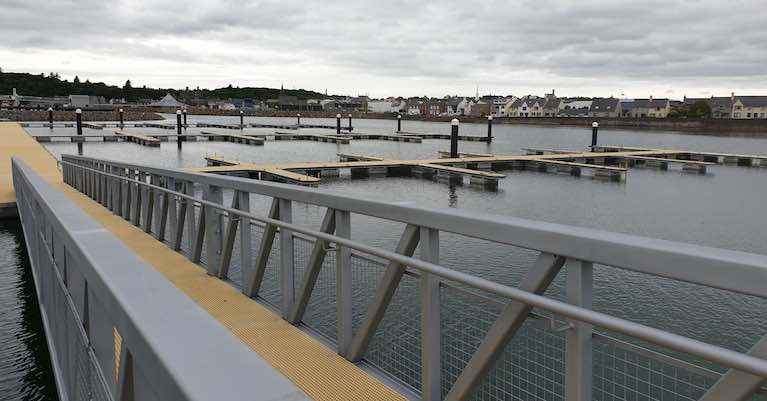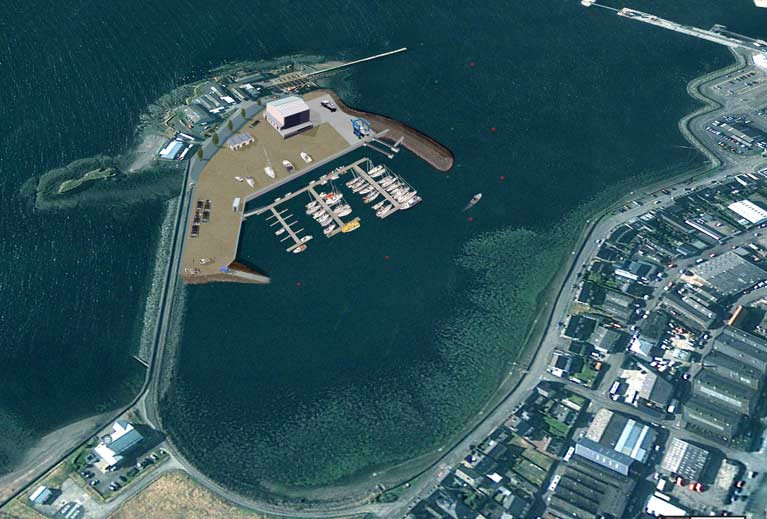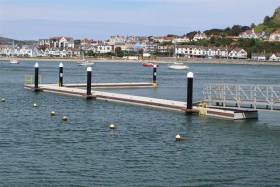Displaying items by tag: Inland and Coastal Marina
Inland & Coastal's Concrete Breakwaters Navigate Birr Town Centre on Way to Australia
Some of the largest concrete breakwaters to have ever been transported by road left Cork Harbour almost a year ago destined for a large international wave attenuation project in Geelong, Australia.
As the UK's Marine Industry News reported, the massive structures travelled by night to disrupt traffic as little as possible on its way to the Port of Cork. The convoy passed through small towns, where street signage and other structures had to be taken down to accommodate the wide load. Even on the motorways, toll booths had to be disassembled to allow passage before it could reach the port where the breakwaters were transferred to cargo ships for the next leg of their journey.
The breakwaters are made by Inland and Coastal Marina Systems which manufactures and exports 6m wide breakwaters from its factory in County Offaly.
“We’re making increasingly larger breakwaters to meet the growing demand to attenuate waves in more exposed sites,” says Maeve Parker, Inland and Coastal Senior Marina Engineer. “We make them in Ireland so that we can tightly control the manufacturing process, ensuring they are high-quality.
The shipping is always a fun challenge though, but the results are well worth it.”
Now the works are nearing completion in Geelong, Afloat will have an update on the Inland and Coastal Marina Systems project from down under shortly. The company has also recently completed an extension to a marina in the Hebrides as Afloat reports here.
Leisure craft berthing at Stornoway Harbour marina in The Hebrides has been boosted to 155 thanks to the completion of works by Offaly firm Inland and Coastal and the installation of 75 new marina berths in Stornoway's Newton Basin.
As Afloat reported in June, The midlands firm designed and built the new pontoons using its own GRP mini-mesh decking, giving the much needed additional berths excellent anti-slip properties.
Protected by a state-of-the-art breakwater, the new Scottish berths will welcome their first resident boats in the New Year.
Offshore energy sector
This month, the busy Irish marine firm is also exhibiting at RenewableUK’s virtual Global Offshore Wind event 2020 from 28-30 October. Inland and Coastal is in the Enterprise Ireland pavilion, showcasing its 'Operational and Maintenance Base' pontoons for the offshore energy sector.
Inland & Coastal Marina Systems Appointed to Replace Port Dinorwic Marina Pontoons in North Wales
County Offaly firm Inland and Coastal Marina Systems (ICMS) has been appointed by The Marine and Property Group Ltd as part of a major project to modernise its Port Dinorwic Marina.
The busy marine firm that hails from Banagher in the Faithful county recently installed pontoons in Stornoway, The Hebrides as Afloat reported previously here.
Acquired by The Marine Group in 2017, the 180-berth full-service marina on the coast of North Wales will receive a complete refresh of its marina hardware as part of a major upgrade project.
As much of the existing infrastructure as possible will be adapted, but where this isn’t feasible ICMS will replace walkways and finger pontoons completely with its highly respected Glass Reinforced Concrete (GRC) decked pontoons. The aesthetically pleasing GRC decking remains slip resistant when wet and doesn’t rot, considerably reducing maintenance costs while increasing the longevity of the marina system.
“We are investing in several areas at Port Dinorwic Marina, including the installation of club standard washrooms, upgraded food and beverage outlets and common areas with the aim of ensuring our berth holders and visitors enjoy a first-class experience for many years to come,” says Christopher Odling-Smee, Director of The Marine & Property Group.
“We’ve chosen to work with Inland and Coastal Marina Systems as not only do they produce quality durable pontoon systems, but the team is keen to work with, and utilise, much of what currently exists, making the most efficient use of time and resources.”
Inland and Coastal Marina Systems’ Managing Director, Oliver Shortall comments: “It’s great to be involved in such an interesting project. Our GRC pontoons will provide safe and stable berthing for a long time to come at this picturesque location.
“As part of our sustainability effort, we always endeavour to work with existing infrastructure as much as possible, and we’re pleased to be able to incorporate established marina components while modernising the facilities at Port Dinorwic Marina.”
Port Dinorwic Marina is a Grade II listed marina and offers swinging moorings, a motorboat launching service and winter storage, in addition to annual and seasonal berthing. Boat sales, boatyard services and engine servicing are also available onsite.
Later this summer, local and visiting leisure craft to Stornoway Harbour in The Hebrides will be enjoying 75 new marina berths in its Newton Basin – increasing capacity for leisure craft to 155. The new facilities, designed and built by County Offaly's Inland and Coastal Marina Systems (ICMS), will be protected by a state-of-the-art breakwater and complement the existing 80 berth marina that was expanded previously in 2014.
With demand again currently exceeding supply for berthing in Stornoway, ICMS is installing its leisure marina walkway and finger pontoons as part of Stornoway Port Authority’s 2017 Masterplan. The GRP mini-mesh decked pontoons will provide the much-needed additional marina berths, all with excellent anti-slip properties.
The Outer Hebrides is a key sailing destination for visitors, and Stornoway is an important link in the chain of safe havens stretching from the Butt of Lewis to the Isle of Barra. The marina’s situation on the Isle of Lewis makes access to the mainland and construction plant challenging.
 The Stornoway Harbour Marina pontoon in the Hebrides
The Stornoway Harbour Marina pontoon in the Hebrides
“Being in the Hebrides has its logistical issues when it comes to installation, but we always find a solution,” explains Brian Curley, Inland and Coastal Senior Project Manager. “Assembling the pontoons offsite really helps timewise and reduces the amount of specialist machinery needed in-situ.
“This exciting project will also incorporate a new slipway and boat hoist, enabling the marina to offer boatyard services to visitors and port users,” continues Brian. “We are delighted to be involved in such a prominent project in Scotland, which will be enjoyed by locals, sailors from aboard and the wider community long into the future.”
Inland & Coastal Marina Systems Provides Conwy Marina with Waiting Jetty Solution
County Offaly marina firm Inland and Coastal Marina Systems has successfully upgraded the ‘waiting’ jetty at Conwy Marina in North Wales. The new pontoon is now in constant use, providing users with a safe and secure place to wait for entrance into the marina.
Inland and Coastal installed a Continuous Concrete Pontoon (CCP), increasing berthing and load capacity for larger vessels. With greater wave reduction and stability properties, the system also requires less maintenance.
Due to varying water levels between the outer harbour and marina basin, access to the 500-berth marina is via a tidal sill.
“The large tidal range in the estuary here often causes the holding pontoon to ground at low water springs,” says Jon Roberts, Conwy Marina Manager. “Inland and Coastal’s continuous pontoon design works perfectly. The attention to detail also made the installation process extremely efficient. The work progressed during specific tidal gates without interfering with daily operations and I am delighted with the quality of the new structure.’’
Jon continues: “Our customers’ first impression of the marina comes from their experience on the waiting pontoon. The new pontoon, with its additional safety features and the reangled ramp to give less steep walk ashore access, make me confident that we are giving the best welcome possible.”
“Conwy is a stunning part of the coastline,” says Oliver Shortall, Inland and Coastal Managing Director. “We were delighted to provide a robust ‘waiting’ jetty. Our concrete pontoons have double the lifespan of wooden ones. The solid surfaces also offer much better grip properties - especially when wet.”
As well as continuously developing pontoon solutions for marina operators, yacht clubs and port authorities, Inland and Coastal is the official UK supplier of SeaBin, demonstrated at the recent Southampton International Boat Show.
Inland and Coastal will be exhibiting at METSTRADE on stand 05.514 in the Marina and Yard Pavilion.



























